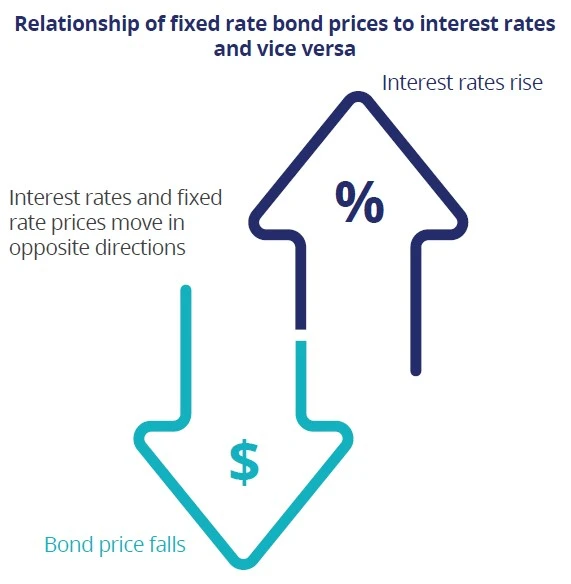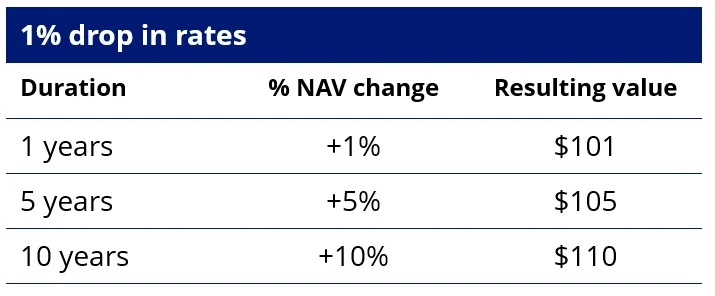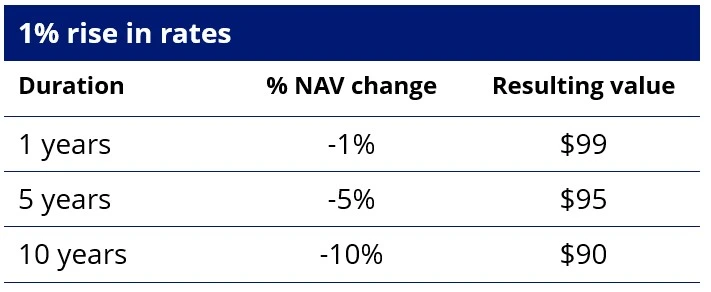Bond basics and the most important factor affecting bond prices
With economic growth forecast to be slowing in the immediate future, many investors are considering their asset allocation and moving from higher-risk shares, where the outlook for earnings is hazy, to lower-risk bonds, where the income is more dependable and where rates are well above the record lows they were two years ago.
During the week, VanEck launched three Australian Government bond ETFs. Each with a different time to maturity range. Here we discuss what bonds are, what affects their price and how our new funds, together with our existing funds can be used as tools by investors to build more robust portfolios.What are bonds?
Bonds are a type of loan set over a fixed period. Investors lend money to a bond issuer and in return, they will receive regular interest payments until the bond matures, when they will receive full repayment of their capital.
Bonds are issued at a particular face value, with a ‘coupon’ or interest rate. The coupon is usually fixed from the time the bond is issued through to its maturity. For example, a 5-year government bond with $100 face value and a 5% coupon will pay investors $5 a year in interest payments per $100 of principal invested over the duration of the bond. At the end of the loan, the bond issuer will pay the lender the final $5 plus repay the total amount of capital, $100.
A secondary bond market exists which allows bondholders to buy and sell bonds before maturity. It is in this secondary market that bond prices are set. In this market, interest rate movements can erode the value of a bond, or the price at which it is traded. This is true of all bonds which have coupons that are fixed for the duration, whether they are Australian government bonds, corporate bonds, global bonds or high-yield bonds.
Factors affecting a bond’s price
The most important factor affecting a bond’s market price is the level of interest rates. When interest rates fall, existing fixed-rate bonds of all types become more valuable as they continue paying out the same coupon even though interest rates have fallen.
On the other hand, if interest rates rise, fixed rate bonds become less valuable because their coupons are static and they therefore trade at a ‘discount’. The chart below shows this relationship.
Duration measures a bond price’s sensitivity to interest rate changes. The longer the duration of a bond, the more the bond’s price will move when interest rates change. This is called duration risk. For example, if the duration of a bond is 5, that means that with a 1% rate rise, the value of the bond would fall ~5%. But if the duration is 1, then the bond’s value would only fall by ~1% if rates rose 1%.
You can see this in the tables below. Rate changes impact bonds with different durations differently and those with longer durations experience greater fluctuations.
Assuming the bond’s value is $100


Source: VanEck. For illustrative purposes only.
Along with an individual bond, any bond fund or bond exchange traded fund (ETF) will have a particular level of duration. The weighted average duration can be calculated for an entire bond portfolio, based on the duration of all individual bonds in the portfolio.
Taking bets on rate movements
By choosing a bond or bond fund of a particular duration, investors can manage the interest rate risk of their bond investment.
Active bond fund managers claim they can add value by finding investment opportunities that either capture yield or mitigate duration risk. Where an active fund manager sits on duration will depend on their view of interest rates.
If, for example, an active manager thinks interest rates will go up, the manager will shorten the duration of their portfolio to reduce duration risk. But if the manager thinks rates will fall, they will lengthen the duration. Investors can easily check a bond fund’s duration by checking with the fund manager.
VanEck’s three new Australian government bond ETFs, launched during the week provide investors with a way to manage their duration risk if they wish to:
- VanEck 1-5 Year Australian Government Bond ETF (ASX code: 1GOV) - a portfolio of Australian government bonds that have maturity dates between 1 and 5 years.
- VanEck 5-10 Year Australian Government Bond ETF (ASX code: 5GOV) - a portfolio of Australian government bonds that have maturity dates between 5 and 10 years.
- VanEck 10+ Year Australian Government Bond ETF (ASX code: XGOV) - a portfolio of Australian government bonds that have maturity dates between 10 and 20 years.
1GOV has the lowest duration. XGOV has the longest duration.
Each ETF has the potential to provide steady and reliable income, paid monthly.
Managing duration risk is difficult which is why we would recommend you speak to your financial adviser to determine which fixed-income investment is right for you.
An investment in the ETFs carry risks associated with: interest rate movements, bond markets generally, issuer default, credit ratings, country and issuer concentration, liquidity, tracking an index and fund operations. See the PDS for more details.
Published: 27 September 2023
Any views expressed are opinions of the author at the time of writing and is not a recommendation to act.
VanEck Investments Limited (ACN 146 596 116 AFSL 416755) (‘VanEck’) is the issuer and responsible entity of all VanEck exchange traded funds (Funds) listed on the ASX. This is general advice only and does not take into account any person’s financial objectives, situation or needs. The product disclosure statement (PDS) and the target market determination (TMD) for all Funds are available at vaneck.com.au. You should consider whether or not an investment in any Fund is appropriate for you. Investments in a Fund involve risks associated with financial markets. These risks vary depending on a Fund’s investment objective. Refer to the applicable PDS and TMD for more details on risks. Investment returns and capital are not guaranteed.




